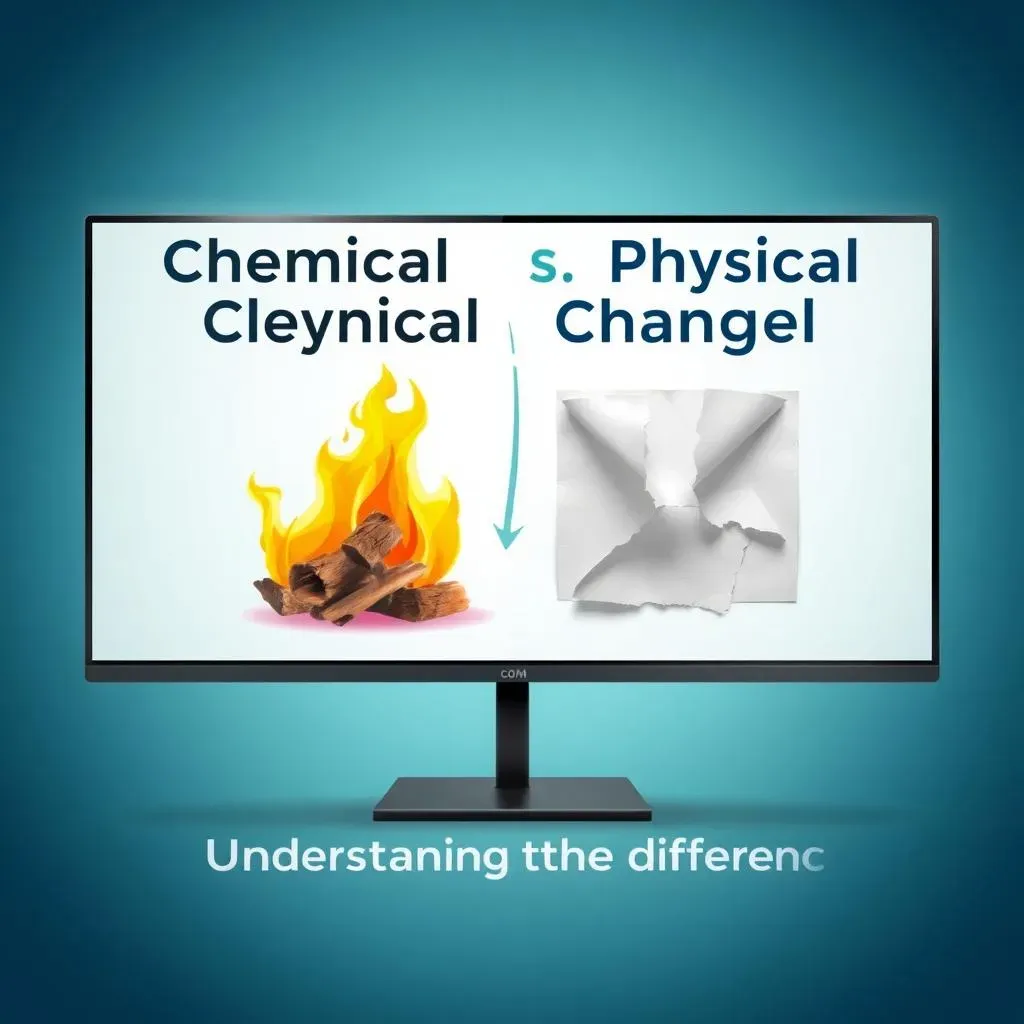Table of Contents
Have you ever wondered, "Is cutting paper a chemical change?" It seems like a simple question, but it delves into the fundamental difference between physical and chemical changes. This article will unravel the mystery surrounding this everyday action. We'll explore the core concepts of chemical and physical changes, using clear examples to illustrate the distinction. You'll learn why the seemingly simple act of cutting paper falls squarely into the category of a physical change, not a chemical one. We'll also tackle some common misconceptions about this topic, clearing up any confusion you might have. By the end of this exploration, you'll not only understand why cutting paper isn't a chemical change but will also have a solid grasp of the broader concepts of chemical and physical transformations. Get ready to discover the fascinating science hidden within a simple act – let's explore whether cutting paper is a chemical change together! Prepare to have your assumptions challenged and your understanding of basic chemistry enhanced. This journey into the world of "is cutting paper a chemical change" will be both enlightening and surprisingly engaging!
Understanding Chemical vs. Physical Changes: Is Cutting Paper a Chemical Change?
Understanding Chemical vs. Physical Changes: Is Cutting Paper a Chemical Change?
Defining Chemical Changes
Let's start with the basics. A chemical change, also known as a chemical reaction, is when a substance transforms into a completely new substance with different properties. Think about burning wood; it turns into ash and smoke – entirely different materials! The chemical bonds within the wood molecules are broken, and new bonds are formed, creating entirely new compounds. This is a key indicator of a chemical change: the creation of new substances.
Another classic example is rusting. Iron reacts with oxygen in the air to form iron oxide, which is rust. The iron’s properties have completely changed; it’s become brittle and orange instead of shiny and gray. The original substance (iron) is gone, replaced by a new substance (rust). This irreversible change is another hallmark of chemical reactions.
Characteristic | Chemical Change | Physical Change |
|---|---|---|
New substance formed? | Yes | No |
Reversibility | Usually irreversible | Usually reversible |
Energy change | Often involves significant energy changes (heat, light) | May involve small energy changes |
Defining Physical Changes
Now, let's look at physical changes. These are changes that affect the form or appearance of a substance but don't alter its chemical composition. Think about melting an ice cube. It changes from solid to liquid, but it's still water – H₂O – throughout the process. You can freeze it again, and you'll get the same ice cube back (more or less!). That's a physical change.
Similarly, tearing a piece of paper is a physical change. You've changed its shape and size, but it's still paper. The chemical makeup of the paper hasn't changed; it's just been broken into smaller pieces. You could theoretically (though messily) try to glue the pieces back together, restoring its original form. This reversibility is a significant characteristic of physical changes.
- Change in shape or size
- Change in state (solid, liquid, gas)
- Dissolving (solution formation)
- No new substance is formed
The Science Behind Cutting Paper: Why It's a Physical Change
The Science Behind Cutting Paper: Why It's a Physical Change
The Molecular Structure Remains Intact
When you cut paper, you're essentially separating it into smaller pieces. Think of it like this: imagine a long chain made of tiny links. Cutting the chain breaks it into shorter chains, but the individual links themselves remain unchanged. Similarly, the cellulose fibers that make up paper are still intact after being cut. Their chemical bonds haven't been broken; they've just been physically separated.
The key here is that the chemical composition of the paper – the types and arrangement of atoms and molecules – remains the same. This is the defining characteristic of a physical change. No new substances are formed during the cutting process; it's simply a rearrangement of existing material.
Before Cutting | After Cutting |
|---|---|
Intact sheet of paper | Smaller pieces of the same paper |
Cellulose fibers connected | Cellulose fibers still connected within each piece |
Same chemical composition | Same chemical composition |
No New Chemical Bonds Are Formed
Unlike a chemical change, where new chemical bonds are formed or broken, cutting paper involves only the disruption of existing physical forces between the cellulose fibers. These forces, such as van der Waals forces, are weak intermolecular attractions. Cutting the paper doesn't alter the strong covalent bonds within the cellulose molecules themselves.
Imagine trying to build a LEGO castle. You can take it apart and rearrange the bricks into different shapes, but the individual LEGO bricks remain unchanged. Cutting paper is similar; you're rearranging the cellulose fibers, but the chemical structure of those fibers remains the same. This lack of chemical bond alteration is another crucial indicator of a physical change.
- No new molecules are created
- No chemical reactions occur
- Only physical forces are disrupted
- The chemical properties of the paper remain the same
Reversibility (In Theory): Putting the Pieces Back Together
While practically impossible to perfectly reassemble a cut piece of paper, the theoretical reversibility highlights the physical nature of the change. If you had incredibly precise tools and enough patience, you could potentially rejoin the separated cellulose fibers, restoring the paper to its original form. This is unlike a chemical change, where the formation of a new substance makes it practically impossible to reverse the process.
Consider burning paper as a contrast. The chemical reaction of combustion transforms the paper into ash and gases, creating entirely new substances. You can't simply put the ash and gases back together to get the original paper. This irreversibility is a hallmark of chemical change, further emphasizing that cutting paper is purely a physical transformation.
Common Misconceptions About Cutting Paper and Chemical Changes
Common Misconceptions About Cutting Paper and Chemical Changes
The "New Substance" Fallacy
One common misconception is that because cutting paper results in different-shaped pieces, a new substance must have been formed. This is incorrect. While the *form* of the paper has changed (it's now in smaller pieces), its chemical composition remains identical. The cellulose fibers that make up the paper are still the same cellulose fibers, just rearranged. It's crucial to remember that a chemical change necessitates the creation of a fundamentally new substance, not merely a change in physical dimensions.
Think of it like sculpting clay. You can shape and reshape the clay endlessly, creating various forms, but it remains clay. Similarly, cutting paper alters its shape but doesn't change its inherent chemical makeup. The fact that you have multiple pieces instead of one doesn't signify a chemical transformation.
Misconception | Correct Understanding |
|---|---|
Cutting creates a new substance. | Cutting only changes the physical form, not the chemical composition. |
Changed shape = chemical change. | Changed shape can be a physical change. |
Confusing Physical Changes with Chemical Reactions
Another frequent misunderstanding stems from a lack of clarity between physical and chemical changes. Many people associate any alteration in a substance's state or appearance with a chemical reaction. However, numerous everyday occurrences, including cutting paper, are purely physical changes. These changes only affect the physical properties – shape, size, state – and not the chemical identity of the material.
This confusion arises because both physical and chemical changes can involve energy transfer. However, the key difference lies in whether new substances are formed. In a physical change, like cutting paper, no new substance emerges. The energy involved simply overcomes the weak intermolecular forces holding the paper together, resulting in a change of form, not composition.
- Melting ice is a physical change (water remains water).
- Boiling water is a physical change (water remains water).
- Crushing a can is a physical change (the metal remains the same).
- Cutting paper is a physical change (it remains paper).
Ignoring the Reversibility Aspect
The reversibility (or at least theoretical reversibility) of a change is a strong indicator of whether it's physical or chemical. While perfectly reassembling a cut piece of paper is practically challenging, it's theoretically possible. You could, in principle, rejoin the separated cellulose fibers. This contrasts sharply with chemical changes, which are usually irreversible, as they involve the formation of entirely new substances with different properties.
Consider burning wood. The wood is irreversibly transformed into ash and gases. You can't magically reverse this process to get the original wood back. However, cutting paper, while messy to reverse, demonstrates the potential for restoration to its original form, underlining its classification as a physical change.
